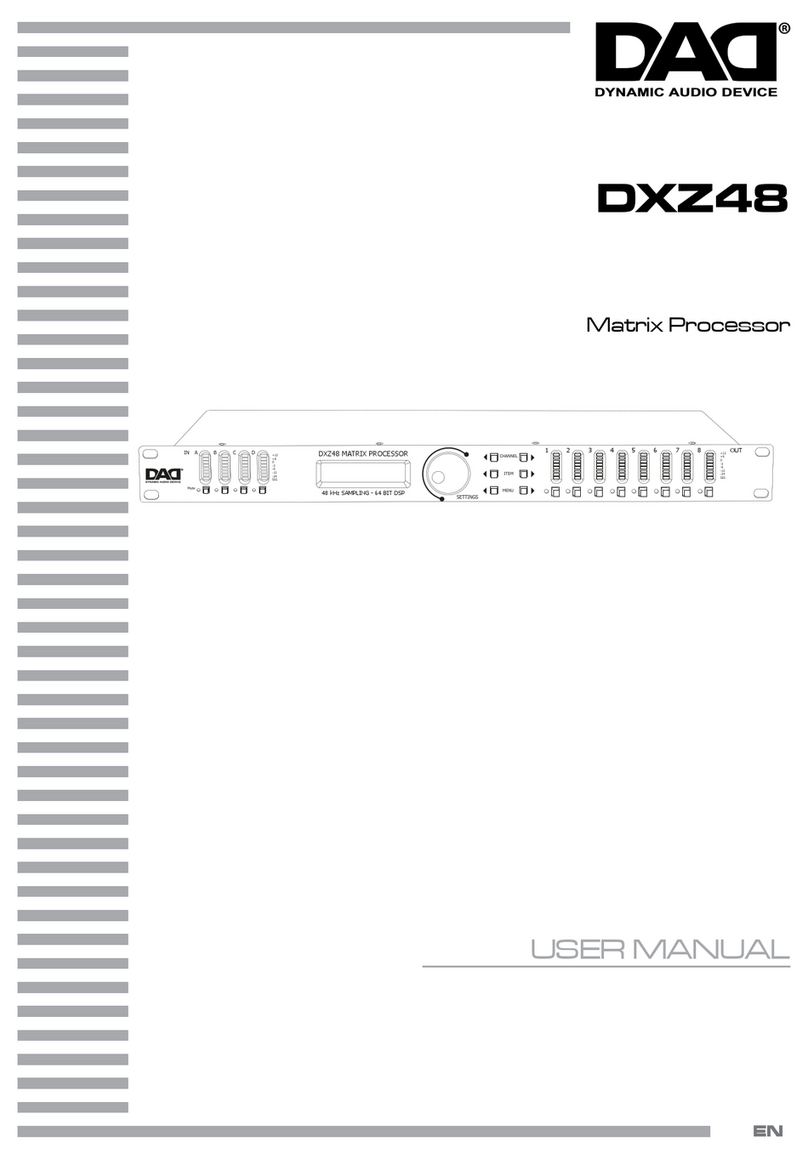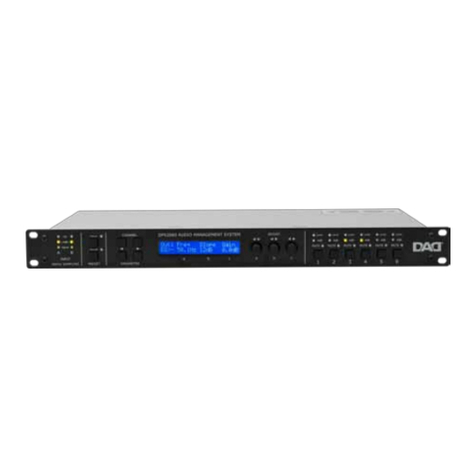
9
IGB
DSX26
3. DISPLAY: questo display si può suddividere in
quattro zone di lavoro.
- La zona in alto a sinistra mostra la modalità del
DSX26 ( Input o Output).
- La parte in basso a sinistra mostra i parametri
attualmente selezionati associati alla modalità di
cui sopra.
- La parte in basso a destra mostra il valore
associato a tali parametri.
- La zona in alto a destra mostra solo le informazioni
riguardanti lo stato attuale del DSX26.
4. ENCODER ROTATIVO: alla destra dello schermo
di visualizzazione si trova un encoder rotativo
continuo che, se ruotato, modica i parametri del
processore. Se viene premuto permette di muoversi
attraverso le modalità ingresso e uscita, mentre se
viene contemporaneamente, mantenuto premuto
e ruotato, permette una rapida selezione delle
stesse.
5. PREV/NEXT: questi tasti permettono di accedere
alle modalità ingresso e uscita e di selezionare il
parametro da regolare. Inoltre, PREV permette di
accedere al Setup del processore.
6. (___e___) mediante questi tasti è possibile
modicare il valore del parametro selezionato nelle
modalità ingresso e uscita.
7. RECALL AND SAVE - ENTER: si utilizza per salvare
programmi in un nuovo indirizzo di memoria e
richiamare le impostazioni salvate in memorie
interne. Per caricare un programma memorizzato
premere tasto RECALL sul pannello frontale.
Utilizzare i tasti PREV/NEXT a destra del display
per scegliere il programma voluto. Premere
nuovamente RECALL per richiamare il programma.
Il tasto SAVE può essere utilizzato anche come
tasto ENTER per la conferma di alcune operazioni.
Premendo il tasto SAVE, in modalità RECALL, si
esce dall’operazione e premendo RECALL durante
un’operazione di salvataggio si otterrà lo stesso
risultato.
8. INTERRUTTORE ON/OFF.
9. FORI DI FISSAGGIO per il montaggio rack.
10. MUTE: premendo uno qualsiasi dei tasti MUTE sul
pannello frontale il canale corrispondente entrerà
in modalità MUTE. Il LED accanto al tasto diventa
rosso quando l’uscita è in MUTE.
11. SPINA DA PANNELLO VDE per il collegamento
ad una presa di rete (240V~/50-60Hz) tramite il
cavo rete in dotazione. Sotto la presa si trova il
portafusibile.
12. CONNETTORE RS232.
13. MIDI OUT/ MIDI IN/ MIDI THRU.
14. OUTPUT 1÷6.
15. INPUT A-B.
3. DISPLAY: this display can generally be addressed in
four working areas.
- The top left shows the mode that the DSX26 is in
(Input or Output).
- The button left displays the currency the currently
selected parameter associated with the above
mode.
- The button right area indicates the value
associated with this parameter.
- The top right only displays information relating to
the current state of the DSX26.
4. THE ROTARY ENCODER: to the right of the
display screen there is a continuous rotary encoder
that, when turned, changes the values in the value
area of the screen. If this control is pushed in it will
step through the inputs and outputs modes. If
held down and turned it will enable fast switching
through the available modes.
5. PREV NEXT: These enables buttons through the
various screens and to both select a parameter to
adjust (PREV/NEXT) and to ne adjust the value of
the currently selected parameter.
6. (___and___) where the parameter is non numeric
these keys scroll through a list of options.
7. RECALL AND SAVE - ENTER: used to save edited
Programs to a new memory location and to recall
saved setups from the internal memories. To select
a recongured Program press the RECALL button
on the front panel. From new the manual does
not contain any preset Programs but, if the unit
has been used before it may contain user pre-
programmed set-ups. Use the PREV/NEXT buttons
located on the right side of the display to choose
the correct Program.
Press RECALL again to enable the Program. The
save key is also used as an ENTER button to conrm
certain operations. Pressing the SAVE key when in
recall mode will exit the operation and pressing
RECALL in a save operation will.
8. POWER SWITCH ON/OFF.
9. MOUNTING HOLES for xing the rack.
10. MUTE: press any of the front panel Mute keys to
toggle the channel in and out of mute. The button
will light red when the output is muted.
11. VDE PANEL PLUG: this plug is connected to the
socket (240V~/50-60Hz) through the supplied
mains cable. The mains fuse support is located
below the mains plug.
12. CONNECTOR RS232.
13. MIDI OUT/ MIDI IN/ MIDI THRU.
14. OUTPUT 1÷6.
15. INPUT A-B.





























